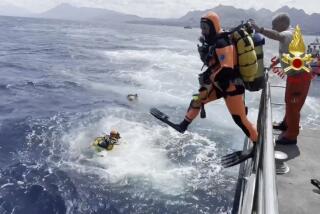Costa Concordia: A hulking reminder of tragedy sits off Giglio, Italy
- Share via
GIGLIO, Italy — This summer, tourists on the Tuscan island of Giglio have been heading for the pretty palm-lined beach at the port, soaking up the sun and swimming out to a line of buoys. Beyond is the capsized cruise ship Costa Concordia, sitting in shallow water where passengers were sucked to their deaths by whirlpools created as the giant vessel lurched onto its side.
Nineteen months after the 950-foot-long ship slammed into rocks off this Mediterranean island and came to a precarious rest on two granite outcrops, the captain, Francesco Schettino, is on trial on charges of manslaughter in the deaths of 32 people who never made it ashore on the night of Jan. 13, 2012.
Salvage crews and divers are working around the clock to prepare for hoisting the 114,000-ton ship upright in September, before winter storms make the wreck, with its sodden mattresses, scattered deck chairs and rotten food, even more unstable.
Tourists marvel at the ship, but then unroll their towels and appear to ignore it, preferring to leap off the floating platform set up for kids or to hunt for crabs in the rock pools where most of the Costa Concordia’s 4,200 bedraggled passengers and crew members crawled to safety.
“We call them pilgrims,” a man who works on the island and declined to be named said of the tourists. “The ship is like a totem; they see it, they think how lucky they are it didn’t happen to them, and decide to enjoy life, which is why they are prepared to soak up the sun right next to it.”
Nick Sloane, who is running the operation for the U.S. company Titan Salvage, doesn’t fault the tourists. “It’s hard not to be amazed,” he said. “Underwater there are still chairs and beds on the sea bed and it is very eerie. Every day you stop and say, ‘Whatever happened here?’ so I understand the interest.”
Life on the quayside has calmed down since the dramatic days in January 2012 when picture-postcard alleys were filled with navy divers taking smoke breaks between desperate attempts to find survivors inside the ship, and restaurants fed plates of mussels to hordes of journalists.
This summer the seafront shop that sold underwear to emergency workers is back to selling sun hats, and kids eat ice cream by the ferry ticket booth where the chief executive of the ship’s Italian operator conducted a tearful news conference.
“For locals, the ship is an alien body. They try not to see it, and the sooner it goes, the better,” said Father Lorenzo Pasquotti, the priest who handed out choir robes to soaked survivors as they staggered into his church.
Illuminated at night by salvage workers and even visible on Google Earth, the Costa Concordia is hard to miss, and residents privately admit that the boom in disaster tourism has been a bonus for restaurants and souvenir shops at the port. Some joke that the statue of the Madonna should be replaced by a statue of Capt. Schettino.
“The port did get a boost last year, but that kind of tourism has dropped this summer and we are now really feeling the economic crisis,” said Massimiliano Botti, the owner of a quayside restaurant.
Now propping up local businesses are the 500 or so salvage workers staying on shore or on rigs set up around the ship.
Botti said he had tried to get the burly Brits and Americans interested in his Tuscan bean soup, but has ended up becoming an expert in making BLTs. “They never try our spaghetti and clams, and insist on adding spicy sausage and even chicken to our pasta carbonara,” he said.
The Giglio job marks a radical change for Titan’s workers, who are accustomed to racing against time to save remote wrecks before monsoon storms devour them, wading through lower decks filled with sewage and rats. At times their work has taken them to war zones.
Sloane and his team are also under pressure to right the Costa Concordia next month onto underwater platforms, amid worry that the ship will become too unstable if left pinioned on the rocks for another winter. Then in the spring comes the tricky task of refloating it using 11-story-high flotation tanks welded to its side and towing it off to be broken up.
But as the workers sweat before computers in their operations center at a commandeered hotel overlooking the crowded beach, distractions are rife. Sloane said he knew of one Briton who was conducting a “serious romance” with a resident, but added, “I suspect mothers here may have warned their daughters to be careful.”
The biggest hit with locals was the Dutch team that preceded the Titan crew, assigned to pumping the fuel out of the Costa Concordia’s tanks. After winning favor by buying rounds of beer in the bars and chatting with fisherman, the Dutch were given a heroes’ farewell the day they left, with boats honking and waiters waving tablecloths on the quayside.
“The Americans and the British aren’t quite as sociable,” Father Lorenzo said. Laughing, he added, “And their ships arrive loaded with peanut butter and all that terrible stuff.”
Kington is a special correspondent.
More to Read
Sign up for Essential California
The most important California stories and recommendations in your inbox every morning.
You may occasionally receive promotional content from the Los Angeles Times.













